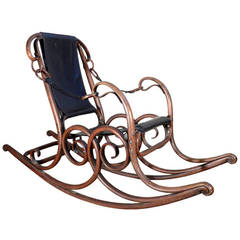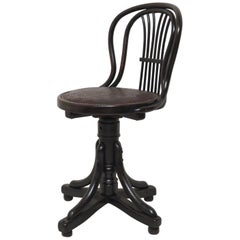1800s Bentwood Chairs
Recent Sales
Antique 19th Century Austrian Chairs
Antique 1890s Austrian Art Nouveau Chairs
Wood
Finding the Right Seating for You
With entire areas of our homes reserved for “sitting rooms,” the value of quality antique and vintage seating cannot be overstated.
Fortunately, the design of side chairs, armchairs and other lounge furniture — since what were, quite literally, the early perches of our ancestors — has evolved considerably.
Among the earliest standard seating furniture were stools. Egyptian stools, for example, designed for one person with no seat back, were x-shaped and typically folded to be tucked away. These rudimentary chairs informed the design of Greek and Roman stools, all of which were a long way from Sori Yanagi's Butterfly stool or Alvar Aalto's Stool 60. In the 18th century and earlier, seats with backs and armrests were largely reserved for high nobility.
The seating of today is more inclusive but the style and placement of chairs can still make a statement. Antique desk chairs and armchairs designed in the style of Louis XV, which eventually included painted furniture and were often made of rare woods, feature prominently curved legs as well as Chinese themes and varied ornaments. Much like the thrones of fairy tales and the regency, elegant lounges crafted in the Louis XV style convey wealth and prestige. In the kitchen, the dining chair placed at the head of the table is typically reserved for the head of the household or a revered guest.
Of course, with luxurious vintage or antique furnishings, every chair can seem like the best seat in the house. Whether your preference is stretching out on a plush sofa, such as the Serpentine, designed by Vladimir Kagan, or cozying up in a vintage wingback chair, there is likely to be a comfy classic or contemporary gem for you on 1stDibs.
With respect to the latest obsessions in design, cane seating has been cropping up everywhere, from sleek armchairs to lounge chairs, while bouclé fabric, a staple of modern furniture design, can be seen in mid-century modern, Scandinavian modern and Hollywood Regency furniture styles.
Admirers of the sophisticated craftsmanship and dark woods frequently associated with mid-century modern seating can find timeless furnishings in our expansive collection of lounge chairs, dining chairs and other items — whether they’re vintage editions or alluring official reproductions of iconic designs from the likes of Hans Wegner or from Charles and Ray Eames. Shop our inventory of Egg chairs, designed in 1958 by Arne Jacobsen, the Florence Knoll lounge chair and more.
No matter your style, the collection of unique chairs, sofas and other seating on 1stDibs is surely worthy of a standing ovation.
- What is a bentwood chair?1 Answer1stDibs ExpertFebruary 22, 2021A bentwood chair is a chair made out of wood that has been steamed and formed into its desired shape. The iconic No. 14 chair made by Thonet is a well-know chair made in this technique. There are many bentwood chairs for sale on 1stDibs.
- Were there safes in the 1800s?1 Answer1stDibs ExpertMarch 31, 2023Yes, there were safes in the 1800s. Historical records indicate that by 1820, some companies used safes to protect goods from fire. Following market campaigns in the 1840s, more companies and individuals began to purchase safes as an anti-theft measure. Shop a variety of safes on 1stDibs.
- 1stDibs ExpertMarch 22, 2022In the 1800s, miniatures were small portraits. People commissioned them to give as gifts to their loved ones to carry with them. In this way, miniatures were similar to modern wallet photographs. On 1stDibs, find a range of miniature portraits.
- 1stDibs ExpertNovember 4, 2024To identify a bentwood chair, look closely at its back. With a real bentwood chair, an artisan achieves the curved effect by steaming or soaking wood and then bending it. As a result, you won't normally see any tool marks that indicate carving, and each curved component will be an individual piece that is screwed, glued or bolted together. If you spot the “Thonet” name on the seat, it's another good indication that your chair is bentwood, as the maker was famous for this type of seating. If you're still unsure about the type of chair you have, consider seeking the opinion of a certified appraiser or experienced antique dealer. Explore a selection of bentwood chairs on 1stDibs.
- 1stDibs ExpertAugust 15, 2024To identify a bentwood chair, search the piece for a maker's mark. Most often, you will find it under the seat. Once you have located the marking, consult trusted online resources to learn more about the maker. From there, you can find chairs similar to yours in online catalogues to gain more information about your piece. Another option is to have a certified appraiser or knowledgeable antique dealer assist you with the identification process. On 1stDibs, shop a diverse assortment of bentwood chairs.
- When were Bentwood chairs made?1 Answer1stDibs ExpertApril 5, 2022The Bentwood Chair was made by German-Austrian cabinetmaker Michael Thonet in the mid-19th century. His design is still popular with interior designers and homeowners worldwide. Shop a collection of Bentwood chairs from some of the world’s top sellers on 1stDibs.
- 1stDibs ExpertNovember 4, 2024To identify 1800s furniture, first check to see if your piece bears any maker's marks. Should you locate any, researching them using trusted online resources can help you determine the maker and age of your furniture. To determine if unmarked pieces date back to the 19th century, look for tool marks and variations in their carvings and ornamentation. Since 19th-century furniture was handmade, you should expect to find these signs of hand craftsmanship. A piece that shows no marks or inconsistencies in details is likely a contemporary machine-made reproduction. Familiarizing yourself with the characteristics of Rococo, Chippendale, Gothic Revival, neoclassical and other 19th-century styles can also be helpful. If you struggle to make an identification, consider consulting a certified appraiser or knowledgeable antique dealer. On 1stDibs, find a range of 19th-century furniture.
- 1stDibs ExpertNovember 2, 2023During the 1800s, necklaces, earrings, brooches and hair accessories were popular jewelry pieces in styles ranging from Georgian with enamel details to Victorian with floral flourishes. The commonly used gemstones of the 19th century included diamonds, emeralds, rubies, sapphires, garnets and amethysts. Gold was the dominant metal for jewelry, but silver became sought-after during the 1880s and 1890s. Explore an assortment of antique jewelry on 1stDibs.
- 1stDibs ExpertFebruary 13, 2023In the 1800s, safes were usually made of metal like tin plating or sheet iron. Fireproofing the safes proved difficult, and during the 1820s, specific mixtures of materials such as mica, potash lye and alum were used to line a safe’s interior in order to prevent its contents from succumbing to fire damage. Shop a collection of safes on 1stDibs.
- 1stDibs ExpertApril 5, 2022Yes, pocket watches peaked in popularity in the 1800s. The first pocket watch was created in Germany in 1510, but was originally too large for a pocket. In the 1600s, the design began to get more compact, but for a long time pocket watches were a rarity and a symbol of wealth. Shop an array of antique pocket watches on 1stDibs.
- 1stDibs ExpertJune 30, 2023In the 1800s, nightstands were often called commodes. Prior to the advent of indoor plumbing, early nightstands contained a porcelain chamber pot in a cabinet that provided a convenient and private alternative to visiting the outhouse. Today, antique, new and vintage nightstands, which are pieces of bedroom furniture that are often called bedside tables, are typically low-profile tables that are positioned alongside one’s bed or elsewhere in a bedroom. Shop a selection of nightstands on 1stDibs.
- What is 1800s art called?1 Answer1stDibs ExpertNovember 26, 2024What 1800s art is called depends on its age and style, as the century saw multiple movements. Most art historians refer to art that broke from traditional norms, produced in the 1860s and later, as modern art, and everything that preceded it as pre-modern art. Some of the art styles that were popular during the 19th century include Impressionism, Realism, Romanticism, Neoclassicism, Expressionism and Fauvism. Shop a wide range of 19th-century art on 1stDibs.
- 1stDibs ExpertDecember 4, 2023What wedding rings looked like in the 1800s was similar to other Victorian jewelry. The Victorian era spanned from 1837 to 1901, coinciding with the reign of Queen Victoria in the United Kingdom. At the beginning of this period, rings were made of gold and affordable only to the wealthy. Designs for Victorian-era rings often featured repoussé work and chasing, in which patterns are hammered into the metal. Some featured stones secured by collets, settings similar to bezels, with prongs and a closed back. On 1stDibs, find a selection of Victorian wedding rings.
- 1stDibs ExpertJanuary 10, 2025The artist George Catlin's paintings from the 1800s are considered a form of artistic documentation because he depicted what he saw during his travels across North America. Catlin produced many images of Native Americans living their daily lives. In so doing, he provided a glimpse of what life was like for Indigenous people before the rapid westward expansion of settlers forcibly disrupted their traditions and culture. On 1stDibs, shop a variety of George Catlin art.
Read More
All the Furniture in This Organic Modern Soho Loft Can Be Yours
Andrianna Shamaris has filled her epic new home with pieces of her own design.
20 Inviting Dining Rooms Perfectly Arranged for Entertaining
Top interior designers show — and tell — us how to create delectable spaces for hosting dinner parties.
Nobody Puts This Sunny Sofa in a Corner
With its plush cushions, cane details and dazzlingly colorful back, it’s inviting from every angle.
The 21 Most Popular Mid-Century Modern Chairs
You know the designs, now get the stories about how they came to be.
Fred Rigby’s Modular Seating Can Be Configured in So Many Handy Ways
The plush Cove Slipper 2.5 Seater sofa is just one of many convenient combinations from the London-based maker.
This Chubby-Chic Quilted Stool Stands on Its Own Two Feet
Sam Klemick's cool stool is edgy, cozy and environmentally sustainable all at once.
Is Lionel Jadot the Willy Wonka of Upcycled Belgian Design?
From his massive collaborative workshop in a former paper factory, the designer concocts funky furniture from disused materials, as well as luxe hotel interiors like the new Mix Brussels.
Rock Your Cares Away on This Sunny Hand-Crocheted Swing
The boho-chic Enchanted Forest Swing, handmade by marginalized women from Turkey and Syria, is uplifting in every way.

